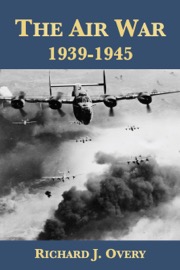 $9.99 on Kindle, Nook, Apple Books, Kobo, Google Play
$9.99 on Kindle, Nook, Apple Books, Kobo, Google PlayThe Air War, 1939-1945 by Richard J. Overy (148,000 words, 14 illustrations)
The Air War, 1939-1945 was first written in the late 1970s when there was very little academic interest in the history of air power. What there was focused largely on combat. The book was intended to provide a global history of the air war by looking at combat, but also the broader context of technology, production, intelligence and leadership. The book sought to address the question of why the Allies in the end won decisively the war in the air, and concluded that Axis air forces were too tied to a narrow conception of air power attached to surface forces, rather than air power exercised in a broader framework of air defense, logistics, strategic bombing and technological development. The book has been assigned reading in military and air force academies for the past forty years.
“The Air War, 1939-1945... immediately and permanently altered the way that historians have examined the nature of aerial warfare during World War II. Overy’s ingenious examination of the global nature of planning, building, deploying, and utilizing air forces remains the finest overall study of the topic more than a quarter-century after its first publication... conclusions drawn in this work... are even today an integral part of U.S. Air Force doctrine.” — Dik A. Daso, US Air Force Chief of Staff’s Reading List
“This is an outstanding book on a subject in which past controversy has often generated more heat than light... The strength of the book is... Overy’s masterly discussion of the economic problems of sustaining air forces in war and of hitting the right balance between quantity production of current models and diversion of resources to research and technical innovation... Truly this is a book that deserves attention from all those who wish to study, and learn from, the history of warfare.” — G. C. Peden, Naval War College Review
“[T]ightly written... The Air War, 1939-1945 is essential reading for all military historians.” — James J. Hudson, Military Affairs
“[O]ne of the best books on aviation in World War II.” — Kenneth P. Werrell, Air Power History
“An important and successful book.” — The Economist
“Highly effective. The result, as so often with sound scholarship, is the ruthless dispelling of myths.” — A. J. P. Taylor, author of The Origins of the Second World War
“The Air War is... an excellent and stimulating book which both needs and deserves slow and careful reading. It is an ambitious book, too, and Dr. Overy should be congratulated for breaking down national histories in writing his history of air power during the Second World War.” — Malcolm Smith, The International History Review
“[A] recognized classic.” — Richard B. Frank, The Journal of American History
“Originally published in 1980 and still the best one-volume aerial history of World War II, Richard Overy’s classic work remains profound and highly original... [it] deepens our understanding not only of World War II but of military history in general.” — The SHAFR Guide Online
“[A]n outstanding book... The Air War is a serious and profound treatise that analyses those various military and civilian themes which, in combination, determined the nature of the struggle in the air during the Second World War... The Air War is something of a novelty in aeronautical literature. It is to be hoped that it will serve as a model for other books to come in this important field.” — Alfred Gollin, The English Historical Review
“Overy provides operational accounts of the air-forces’ role in Europe... and in the Pacific. Then, and most exceptionally, he deals separately with all facets of the air war: planning, organization, manpower, equipment, and doctrine... honest... broadly informed, and... well-stocked with useful data.“ — Kirkus
“R. J. Overy examines the whole war period from the point of view of each of the warring powers and gives us not only a study of military campaigns but also a highly successful examination of aerial doctrine, economic and scientific mobilization, and the political, diplomatic, and military aspects of the management of hostilities. This fine study analyzes the achievements and the failures of the aerial component of the war... This good analysis of many studies done on this subject... makes possible a new, balanced synthesis from an objective point of view.” — Sam H. Frank, The American Historical Review



